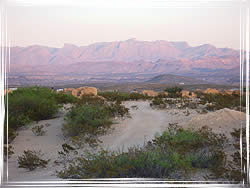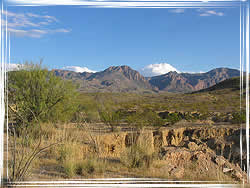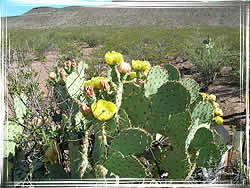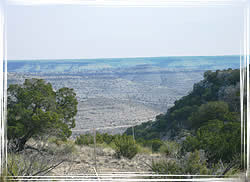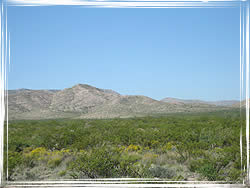Texas Eco-Regions
Trans-Pecosback to Eco-Regions Map
Elevation
Elevation ranges from 1,000 feet above sea level at the low end near the meeting of the Pecos and Rio Grande Rivers to the highest point in Texas, Guadalupe Peak, reaching up to 8,749 feet. On average, elevation ranges between 3,200 and 5,200 feet above sea level.
Precipitation
On the western edge of the Trans-Pecos near El Paso, the average annual rainfall is less than 8 inches, while on the eastern edge near Fort Stockton and Sanderson, average rainfall is around 12-15 inches per year. Summer (July – September) is considered the rainy season. Higher elevations traditionally receive greater rainfall than those at lower levels.
Topography
The Trans-Pecos region can be described as the desert portion of Texas. This region is characterized by mountains, desert valleys, sand hills, rough plateaus, and desert brush land. Variation in vegetation is closely tied to the topography in this region, mostly due to the fact that rain does not fall evenly over the area. The Sky Islands or the mountain ranges which account for a significant portion of change in topography in the Trans-Pecos are what make this part of Texas unique.
Soils
The majority of the soils are alkaline and depending on the mountain range and source of parent material, the soils are either igneous or sedimentary. Caliche is common throughout the region because of the high content of calcium in the soil.
Vegetation Description
The vegetation in the Tran-Pecos is mostly comprised of Chihuahuan Desert species. Commonly found species include honey mesquite, red berry juniper, net-leaf hackberry, cottonwood, desert willow, western soapberry, shin oak, Texas walnut, Mexican buckeye and Ashe juniper in the eastern part of the region. It hosts a diverse mixture of short grasses, desert cacti and wildflowers. Some examples are: creosotebush, tarbush, four-winged saltbush, mariola, and succulents such as cacti, yuccas, agaves, ocotillo, and sotol.
Impacts of Fire
Most fires in the Trans-Pecos region are started by lightning strikes, which are common during the summer storms. For the most part, it has been mostly the large areas of grassland that burn. These fires have kept juniper, pinyon and oak at bay on the higher, wet and cool areas and desert scrub at bay on the lower, dry and hot areas. In some areas, however, overgrazing of cattle, years of drought and the lack of fire has allowed for the encroachment of juniper, mesquite and other invasive vegetation, which are now replacing the once-dominant grass.
Historical Information
The first areas of the Trans-Pecos were populated by both indigenous and European peoples along the Rio Grande River. Permanent Spanish settlements were established on the south side of the river around 1659 in Paso Del Norte (now known as El Paso on the United States side of the river and Ciudad Juarez on the Mexican side.) The areas beyond the river were home to the Mescalero and Lipan Apache tribes, who were nomadic throughout the region. The Comanches controlled the eastern edge of the region. After Texas joined the Union in 1845, with the protection of the U.S. Army stationed in the outposts of Fort Stockton, Fort Davis, Fort Hancock and Fort Bliss, the rich, vast expanses of grasses brought in ranchers in the mid- to late 19th century. Agriculture has always been a major part of the settlements along the Rio Grande with early inhabitants growing grapes, and fruit trees. Paso Del Norte was also a major stop to replenish supplies along the El Camino Real a major trade route between Mexico City and Santa Fe, New Mexico.
Other
Ranching is not as profitable as it once was but is still a major way of life outside the urban areas. El Paso is a large urban area with a population of 600,000 and the neighboring Ciudad Juarez is populated by another 1.5 million people. Technology is moving into Van Horn with the development of a Space Port. Maybe someday folks will be coming to West Texas for a trip to the moon. Agriculture is still strong in areas with good water. Water is a hot topic and always controversial. Pecans, cotton, lettuce, cabbage, onions, alfalfa, wheat, cantaloupe, and chilies are major crops of the area.
